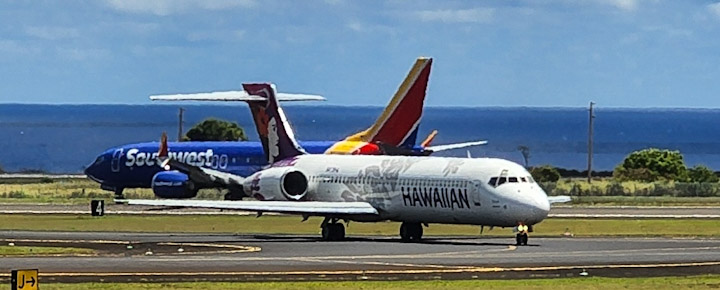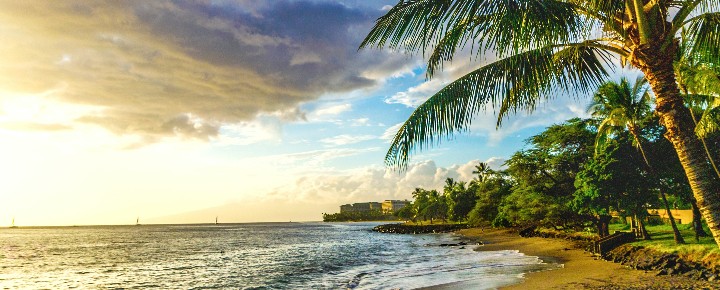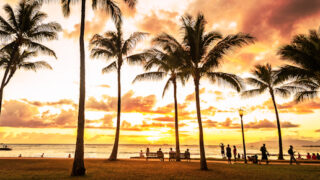Japanese visitors to Hawaii remain at a fraction of normal, and mainland arrivals are down too after the Maui fire. Will Hawaii Governor Josh Green help lure either back? He was betting on Japan first and traveled with a large entourage this week to the Far East. This is his second outreach trip to Japan since he was inaugurated. There are many obstacles in front of him, however, considering the Yen is weak compared to the US dollar. Japanese are not traveling very much internationally now and are visiting domestically instead to help their economy.
After meeting with Japan Airlines and ANA Airlines yesterday, the message back to Hawaii was not to expect an increase in Japanese visitors for two more years. Compared to pre-pandemic travel, Japanese visitors are now down up to 50%. Looking at the week of November 5, the past three years, in 2019, it was close to 6,000 Japanese visitors in that week compared to this year with 3,000 visitors, which is still better than the 1,500 recorded in 2022. While visiting Hawaii is now more expensive for the Japanese, the state has in its arsenal a faster clearance procedure at Honolulu Airport to reduce the current processing wait times.
Should Hawaii look closer to home for its loyal visitors?
Considering all this and the fact that mainland travel to Hawaii remains depressed after the Maui fire, we wonder if the state should be looking at its home turf first, just like the Japanese are asked to do when it comes to their own travel.
While Green’s visit is focused on luring Japanese visitors to return to Hawaii, it also includes giving thanks for Japan’s $2 million contribution made to Hawaii following the Maui fire in August and promoting Hawaii-made merch at the Aloha Market at Tokyo Haneda Airport, which sells island products.


Green advocates for international tourists, fewer low-end visitors, and “any” $50 fee.
Governor Green has long been an advocate for the voice of reduced domestic tourism in Hawaii. His 2022 campaign (still online) indicated that his top administration priorities include “reducing the total number of tourists” and the implementation of a “$50 impact fee for visitors.”
The former has happened of its own accord, while the latter has thus far failed to happen but is by no means gone entirely. Watch for a new $50 fee to return to the state legislature in 2024. Green also aspires to reduce the number of “low-end” Hawaii visitors. It seems, however, that his goals in relation, at least to Japanese visitors, may be entirely different.
Post Lahaina fire Climate Impact Fee replaces prior $50 visitor fee concept.
Since the Maui fires, Green advocated for a revised visitor fee, now coined a Climate Impact Fee. He said that the $50 fee would now be used to benefit firefighting. “We’re going to need money to make sure we have more firefighters, that we have more equipment, and we have more money for investigations like this.”


Everyone still wonders where Hawaii’s highest accommodation tax in the country goes.
The most expensive tax on hotels and vacation rentals in the U.S. is paid by visitors and Hawaii residents who travel. It isn’t apparent how the money is used, especially given the painfully lacking tourism infrastructure, for example, from Hawaii parks to airports, public roads to restrooms.
Will Climate Impact Fee be a further turnoff for mainland visitors and Japanese?
Should any bill eventually be enacted and deemed legal, there might also be permits or licenses obtainable online or at physical locations statewide. Originally thought to be charged via airlines and accommodation providers, that is no longer likely. In any event, enforcement would pose a considerable challenge. The Department of Land and Natural Resources (DLNR) has advocated for such fees and, as the enforcer, would need to staff up. Even then, questions about the feasibility of enforcement remain unanswered. If the fee is still based solely on the use of state-designated resources, even distinguishing between the county and Hawaii state parks, especially for visitors unfamiliar with our local geography, presents a logistical challenge. The uncertainty further extends to the legal aspects of implementing any such fees.
Furthermore, skepticism abounds regarding whether money collected would ultimately support intended purposes or instead funnel into the state’s general fund. The state’s track record in earmarking of funds for special uses remains concerning.
Get Breaking Hawaii Travel News







Doubtful that Japanese visitors will return in large numbers. I was happy to hear announcements in both English and Spanish at Hawaiian Airlines LAX as there were no Japanese travelers ,and Spanish speaking visitors are coming to Hawaii
I have Japanese family, they’re not budging. Hawaii is considered too expensive – especially with the Yen/Dollar exchange rate. Additionally, the islands, Waikiki in particular, are increasingly viewed as unsafe and hostile by many Japanese. They’re turning more and more to destinations such as Taiwan and Thailand for affordable, safe, tropical vacationing. Anecdotal but it’s what I hear from them.
Best
Interesting you bring up the safety, I travelled to Hawaii on Business 1986-2015, the first 20 years maybe 5X/Annum, the last 9, 4X/Annum, since Annually and Waikiki only now, there was never Security issues until the Ige Lock-down and following with the anti-Tourist, especially from the Mainland monolog. It seems in both Kauai and Maui it’s become militant, and in Waikiki there have been issues at night, when never before. Hopefully, that changes for all.
When a Japanese person starts using the words “abunai” (dangerous)and “kitanai” (dirty) as part of their description of what’s supposed to be a premium vacation destination it’s never good… My aunt was floored by the public urination on her last visit a few years ago…
Best regards
I used to think the anti visitor attitude was limited to a vocal minority, but once you start seeing laws passed that restrict visitor access and a two tiered system where only visitors are charged for access to certain areas, you realize the attitude towards tourists runs much deeper.
Also, as other have mentioned the disgusting elitist attitude toward “low value” tourists will likely not play out well, people that truly have the funds to stay anywhere they want will not tolerate run down rooms/facilities at “high end resorts”.
Also, the $50 fee and other fees are just plain insulting and I think part of the intent is to remind visitors of their “place” when visiting and Hawaiians getting their “pound of flesh”.
The way our moron Governor here in Colorado gets around imposing taxes he changes the wording to Fees. In short, we voted in a bill called The Tabor bill. Basically the state cannot impose a tax without a vote by the people. Then if the state has a surplus of tax funds, we get that surplus back as a refund. Fees don’t not need a vote by us. It’s amazing how soon the people that are vote into office forget how they got there.
Governor Green, seems to be very transparent, trying to move the shells in the table, now calling the $50 Fee (Violation of Interstate Commerce) a Climate Fee. This, not unlike, His predecessor Ige, scooping up all the County Room Taxes and putting them in the States General Fund, and creating the highest Room Tax worldwide. To Climate, would it not be more that Politico’s ignored Surveys built over 7 years, that Hawaiian Electric destroyed evidence during the lockdown and The State held back needed water to fight the fire, with trucks unable to go off road and pumps not functioning! It would seem Green, knows not that Japan retreated from Hawaii in the late 1990’s, despite owning most of the Resort hotels in Waikiki. Nice trip!
Also, when city cops pull you over on city road and give you a ticket, the money goes to the state general funds. Talk about slush money.
Be careful what you wish with for with “high-end “ vs. “low-end”. Some of the biggest cheapskates I know are wealthy people. They wouldn’t tip if their lives depended on it.
Hi Curtis.
Thanks for that interesting perspective. And for nearly 200 comments on Beat of Hawaii!
Aloha.
That’s because the “low end” visitors know how hard it is to earn a buck and acknowledge that by giving good tips when they are here and appreciate our Aloha spirit.
The Gov has long been in favor of reducing tourists, especially “low-end” tourists. If he thinks “higher-end” tourists are going to stay in run-down hotels, he has another thing coming.
He should welcome all kinds of tourists. The hospitality workers can hardly afford to live there. He should be begging for mainland visitors.
I don’t know what kind of visitor he’d call me. More than 20 visits usually fly 1st class but stay at the timeshare. Even though we have a kitchen, we typically eat out. Usually at more affordable restaurants, but each vacation includes a trip to the Yard House and the Cheesecake Factory. And, we try to get to Kenneke’s Waimanalo. We only rent a car for 1 or 2 days now – back in the day for 2 weeks.
As a business owner I don’t see a down side with the governors visit to Japan. It’s always a good idea to touch base with a client to let them know when you’re ready we’re ready.
Also I do not get hijacked by worrying about all the fees associated with travel. There isn’t a popular travel destination that doesn’t include taxes or fees. Instead I look at total price if it makes since we go if not to bad.
Lastly I just booked a last minute deal to BI thru Costco Travel. The package included a very good price plus No resort fee, 50 daily resort credit, daily breakfast and rental car, plus a 230 Costco gift card and I scored an excellent price on round trip airfare with Hawaiian for December Price was so good we couldn’t say no.
Hi Richard.
Glad you got a good enough deal that you couldn’t say no. Enjoy the BI!
Aloha.
I’m a working man. Not a high-end visitor. If I come, I will enjoy cycling and camping. I will gladly spend my money at locally-owned joints as much as possible, and stay away from corporations. I will not contribute to driving up the price of housing. But I am concerned and confused as to weather Hawaiians want tourists visiting right now. Many people are saying, “Stay away. We don’t want to be overrun.” I feel that. I am in the entertainment/hospitality business. Others are saying ,”Please come! We need the economic boost.” I visited Hawaii as a kid, in 1984, and have been trying to get back ever since, but I don’t want to come if I’m not welcome.
Hi Todd.
It’s hard to imagine that you won’t have a great time if you decide to return after a hiatus of 40 years. Please enjoy!
Aloha.
Todd,
Certain people would prefer no visitors ever. Don’t worry about it. I have come nearly every year since the late 1970s. Never had a problem.
If you like it, you’ll come again. If not, there’s always the American or British Virgin Islands, Europe, Asia, Africa. LOts of options if it doesn’t work out.
Another good article. But… Dear BoH, you’re in the business of journalism and are in a great and unique position, unlike many of us, to question and interview the politicians we vote for (or don’t) and get answers to your excellent question that everyone would love to know – “Everyone still wonders where Hawaii’s highest accommodation tax in the country goes”? It’s about time someone investigates and gets answers directly from those who are spending our money. After all, part of their job is accountability. Let’s see it. I’d nominate you for Pulitzer Prize if you can accomplish that. Mahalo.
Hi Keoki.
Thanks. We’ll see what we can learn.
Aloha.
Which politician was it that said, “Never let a crisis go to waste”?
The Governor of Hawaii, Josh $50 Green, has apparently taken that to heart by attaching it to the Lahaina disaster.
That would be Rahm Emmanuel, Obama’s chief of staff:
“You never let a serious crisis go to waste”.
“We’re going to need money to make sure we have more firefighters, that we have more equipment, and we have more money for investigations like this.”
Sounds like a personal problem to me. Maybe the Governor should raise the state sales tax. No way, as a tourist, should I be paying into funding Maui’s fire department. This is something that benefits the locals, therefore, they should be the ones funding it. JMHO
What does the governor consider “low-end traveler?” With r/t coach airfares around $1,500 from the east coast, the cost of hotel and car rentals, what figure is “low-end?” What an elitist attitude. Does he even want mainland visitors? Awful!
Apparently us cheap, wet, and cold west coasters are the low-end travelers. Well, he won’t have to worry about us this year. We’re headed the other way. Twice.
Listen, I don’t mind paying a $50 impact fee. It’s the huge increases in room, food, restaurants, and car rentals. The resorts continue to have poor marketing in welcoming us back. The first paragraph on every resort web page, is we are sorry for the fires, and we ask that you respect and honor”…. We all have the message by now. We are adults travelling and very heartfelt adults. I’ve spent 5k to donate to victims. However, dont also tell me to over tip. If I am spending all these monies coming to Maui, that money is allocated to different aspects including the salaries of locals. So Gov Greene needs to begin making it clear , if he can’t have the internatl $, start getting professional marketing advice.
I keep hearing about over tourism, so why is he promoting tourism??
That was my first thought. Then read how he wanted to reduce domestic tourism, but is courting Japanese tourism. Overcrowding caused by tourism and the “impact” on the islands will happen no matter what continent the travelers come from. I am confused does he want tourists or not?
Good luck to the governor with the is approach. As a “mainlander” Californian, we love Hawaii and we’re used to visiting annually, but it has become extremely expensive and the messaging from both the government and vocal anti-tourist locals is a huge turnoff. This year our vacation dollars were used to go to Europe, and next year we are going to Mexico. Despite spending thousands and thousands of dollars on our last trip in 2022, maybe we were the “low end” spenders they want to weed out? If so, mission accomplished!